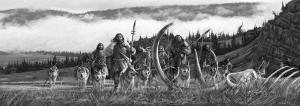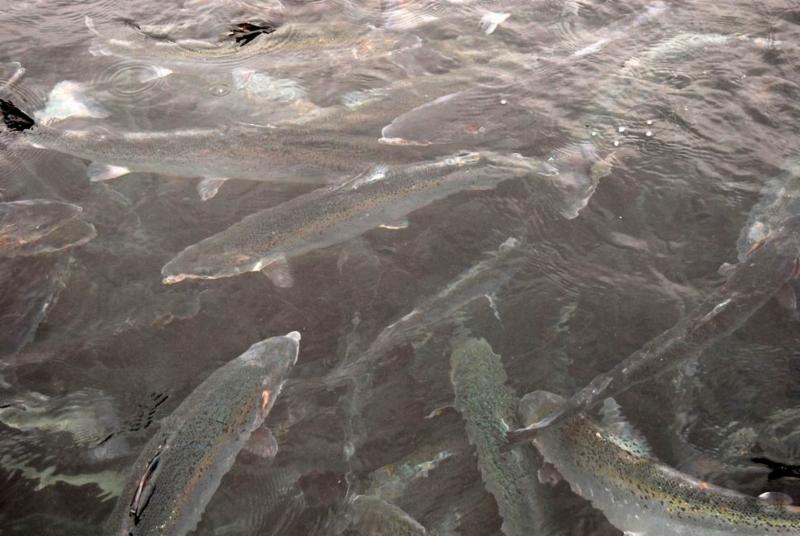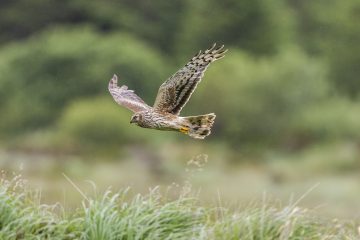How animals shaped the evolution of humans

Wherever you go in the world, whatever ecosystem, whatever culture, people live with animals. Humans are one of the few animals that adopts and cares for other animals. Our cross-species connections might be older and more important than we ever imagined, running throughout human history, driving human evolution for millions of years and even helping us invent language and other tools of civilization. The effect this has had on human psychology, hunting practices, territoriality and social behaviour have been profound.
Human evolution is the lengthy process of change by which people originated from apelike ancestors. Scientific evidence shows that the physical and behavioural traits shared by all people originated from apelike ancestors and evolved over a period of approximately six million years. One of the earliest defining human traits, bipedalism the ability to walk on two legs evolved over 4 million years ago. Other important human characteristics such as a large and complex brain, the ability to make and use tools, and the capacity for language developed more recently. Many advanced traits including complex symbolic expression, art, and elaborate cultural diversity emerged mainly during the past 200,000 years.
A suite of unique physical and behavioural characteristics distinguishes Homo sapiens from other mammals. Three diagnostic human behaviours played key roles in human evolution: tool making, symbolic behaviour and language, and the domestication of plants and animals. Our domestication of animals in particular is what separated us from apes.
Animal domestication is a co-evolutionary process in which a population responds to selective pressure while adapting to a novel niche that included another species with evolving behaviours. Dogs, cats, cows and other domesticated animals played a key role in human evolution, according to a theory being published by paleoanthropologist Pat Shipman of Penn State University. Even before the formal domestication of animals thousands of years ago, humans formed strong bonds with animals that have no obvious counterpart elsewhere in the animal kingdom. According to Shipman this interdependency between humans and animals actually stretches back two and a half million years, and figuring out why our ancient ancestors created these links can help us better understand our overall evolution.
Humans may have begun their connection to animals after they became competitive hunter. That change grew from the development of tools and weapons (to defend oneself) starting around 2.6 million years ago. Next, the need to communicate that knowledge about the behaviour of prey animals and other predators drove the development of symbols and language around 200,000 years ago, Shipman suggests.
We invented the equipment, learned how to track and kill, and eventually took in animals who also knew how to hunt like wolves and other canines. Others, like goats, cows and horses, provided milk, fur or wool used to make clothing or other items and, finally, hides and meat. Humans living in arid regions domesticated hardy camels as reliable mounts and cargo-carriers that could survive long periods without water. The lactase provided by certain animals enabled adult humans to eat milk products without gastric distress. The underlying mutations arose at least twice among cattle-herding people in the past 10,000 years.
 Starting from 40,000 years ago until the present, humans domesticated plants and animals, with highly visible and advantageous results. It has been argued that the domestication of plants and then animals at about 12,000–10,000 B.C. caused the Neolithic Revolution. Domestication is central to understanding the Neolithic Revolution. Domesticating plants and animals gave humans a revolutionary new control over their food sources. Domestication enabled humans to switch from foraging, hunting, and gathering to agriculture and triggered a shift from a nomadic or migratory lifestyle to settled living patterns.
Starting from 40,000 years ago until the present, humans domesticated plants and animals, with highly visible and advantageous results. It has been argued that the domestication of plants and then animals at about 12,000–10,000 B.C. caused the Neolithic Revolution. Domestication is central to understanding the Neolithic Revolution. Domesticating plants and animals gave humans a revolutionary new control over their food sources. Domestication enabled humans to switch from foraging, hunting, and gathering to agriculture and triggered a shift from a nomadic or migratory lifestyle to settled living patterns.
The animal connection gave a selective advantage to humans who had better abilities to observe, to draw conclusions, to communicate, and to make a new sort of living tool. These abilities preadapted humans to live in higher densities and more permanent settlements, as happened once domestication of plants and stock animals occurred.
Animals were domesticated first because their treatment was an extension of tool making, the primary adaptation of the first phase of human evolution, and gathering knowledge about animals, the primary adaptation of the second. It’s argued that the real advantage of animal domestication is using animals as living tools that also provide valuable renewable resources. In essence, domestic animals are another kind of extrasomatic adaptation or tool that expands the resources humans can exploit. Transferring the concept of tool making and tool using from inanimate stone or wood to live animals was a fundamental advance in human evolution predicated on knowledge of biology, ecology, physiology, temperament, and intelligence of target species; of the selective breeding; and of communication techniques based on the animal connection.
 Stone tools, first invented 2.6 million years ago, turned humans into fearsome predators and radically shifted their place in the ecosystem. Humans to deal with this shift by observing the behaviours of potential competitors and potential prey, and the best way to do this was to bring animals permanently into their lives. Those who knew more about animals were more likely to survive in the new paradigm, and this evolutionary advantage explains why humans now form these connections with animals throughout the entire world.
Stone tools, first invented 2.6 million years ago, turned humans into fearsome predators and radically shifted their place in the ecosystem. Humans to deal with this shift by observing the behaviours of potential competitors and potential prey, and the best way to do this was to bring animals permanently into their lives. Those who knew more about animals were more likely to survive in the new paradigm, and this evolutionary advantage explains why humans now form these connections with animals throughout the entire world.
Managing all of these animals — or just tracking them — requires technology, knowledge and ways to preserves and convey information. Shipman has an even more radical proposal that the huge amount of data gathered through the observation of animals created a need for storing and communicating information, which gave rise to figurative art and language. As indirect evidence of this, she points towards the earliest cave paintings:
“Though we cannot discover the earliest use of language itself, we can learn something from the earliest prehistoric art with unambiguous content. Nearly all of these artworks depict animals. Other potentially vital topics – edible plants, water, tools or weapons, or relationships among humans -are rarely if ever shown.” Though it is argued that language arose to communicate about human interactions, the earliest external documentation of information rarely includes human interactions.
 Today, the most widespread form of inter-species bonding occurs between humans and dogs. The concept of friendship has ancient origins, but it may have been enhanced through the inter-species relationship to give a survival advantage. The dog is the first domesticant and had the most profound effect on human evolution. It’s been argued that without dogs you don’t have any other domestication, you don’t have civilization. The dog was domesticated and widely established across Eurasia before the end of the Pleistocene, well before cultivation or the domestication of other animals. Ancient DNA supports the hypothesis that dog domestication preceded the emergence of agriculture and was initiated close to the Last Glacial maximum 27,000 YBP when hunter-gatherers preyed on megafauna, and when proto-dogs might have taken advantage of carcasses left on site by early hunters, assisted in the capture of prey, or provided defence from large competing predators at kill-sites. Wolves were probably attracted to human campfires by the smell of meat being cooked and discarded refuse in the vicinity, first loosely attaching themselves and then considering these as part of their home territory where their warning growls would alert humans to the approach of outsiders. The wolves most likely drawn to human camps were the less-aggressive, subdominant pack members with lowered flight response, higher stress thresholds, less wary around humans, and therefore better candidates for domestication.
Today, the most widespread form of inter-species bonding occurs between humans and dogs. The concept of friendship has ancient origins, but it may have been enhanced through the inter-species relationship to give a survival advantage. The dog is the first domesticant and had the most profound effect on human evolution. It’s been argued that without dogs you don’t have any other domestication, you don’t have civilization. The dog was domesticated and widely established across Eurasia before the end of the Pleistocene, well before cultivation or the domestication of other animals. Ancient DNA supports the hypothesis that dog domestication preceded the emergence of agriculture and was initiated close to the Last Glacial maximum 27,000 YBP when hunter-gatherers preyed on megafauna, and when proto-dogs might have taken advantage of carcasses left on site by early hunters, assisted in the capture of prey, or provided defence from large competing predators at kill-sites. Wolves were probably attracted to human campfires by the smell of meat being cooked and discarded refuse in the vicinity, first loosely attaching themselves and then considering these as part of their home territory where their warning growls would alert humans to the approach of outsiders. The wolves most likely drawn to human camps were the less-aggressive, subdominant pack members with lowered flight response, higher stress thresholds, less wary around humans, and therefore better candidates for domestication.
Later studies support the co-evolution relationship between dogs and humans through their evolution of similar (although obviously not identical) social-communicative skills in both cases adapted for certain kinds of social and communicative interactions with human beings that dogs can discriminate the emotional expressions of human faces, and that most people can tell from a bark whether a dog is alone, being approached by a stranger, playing, or being aggressive, and can tell from a growl how big the dog is. In 2015, a study found that when dogs and their owners interact, extended eye contact (mutual gaze) increases oxytocin levels in both the dog and its owner. As oxytocin is known for its role in maternal bonding, it is considered likely that this effect has supported the coevolution of human-dog bonding.
 Early humans moved from scavaging and small-game hunting to big-game hunting by living in larger, socially more-complex groups, learning to hunt in packs, and developing powers of cooperation and negotiation in complex situations. As these are characteristics of wolves, dogs and humans, it can be argued that these behaviours were enhanced once wolves and humans began to cohabit. Communal hunting led to communal defence. Wolves actively patrol and defend their scent-marked territory, and perhaps humans had their sense of territoriality enhanced by living with wolves. Marking of territory with signs such as pecked cupules, hand stencils and prints, abraded grooves, and finger impressions in once-soft mud are enduring signs used to mark occupation. They also became the first symbolic objects i.e. art. Wolves mark their territory with urine, but humans do not have the keen sense of smell as wolves and would have needed to use something more easily recognizable and enduring to mark their territory. Humans may have learned to mark their territory after watching wolves and dogs, which may have been generative of human culture.
Early humans moved from scavaging and small-game hunting to big-game hunting by living in larger, socially more-complex groups, learning to hunt in packs, and developing powers of cooperation and negotiation in complex situations. As these are characteristics of wolves, dogs and humans, it can be argued that these behaviours were enhanced once wolves and humans began to cohabit. Communal hunting led to communal defence. Wolves actively patrol and defend their scent-marked territory, and perhaps humans had their sense of territoriality enhanced by living with wolves. Marking of territory with signs such as pecked cupules, hand stencils and prints, abraded grooves, and finger impressions in once-soft mud are enduring signs used to mark occupation. They also became the first symbolic objects i.e. art. Wolves mark their territory with urine, but humans do not have the keen sense of smell as wolves and would have needed to use something more easily recognizable and enduring to mark their territory. Humans may have learned to mark their territory after watching wolves and dogs, which may have been generative of human culture.
The animal connection’s transformation of formerly wild beasts into living tools gave humans a decisive edge in adapting to new environments and using the evolutionary advantages of animals for themselves. The uniquely human habit of taking in and employing animals even competitors like wolves spurred on human tool-making and language, which have both driven humanity’s success. By using animals humans had shortcut the evolutionary process. Humans’ strong connection with animals, rather than a desire for food, as the more likely explanation for why people decided to keep animals like dogs and cats around. This animal connection compelled humans to learn about and care for fellow creatures; however this is not the case for the majority of other animals. As humans have come to dominate the planet through their co-evolution with animals, humans have also caused serious damage to variety of different animals through extensive hunting and the destruction of their habitats and often resulting in the extinction of whole species. The problem in modern times is that we have forgotten the nature of the bond we have with animals. We are not upholding our end of the evolutionary arrangement. Considering how animals have had such a positive impact on the development of the modern human it’s only fair that animals’ particularly endangered ones are not over exploited to the point of extinction for nothing but completely selfish reasons.







